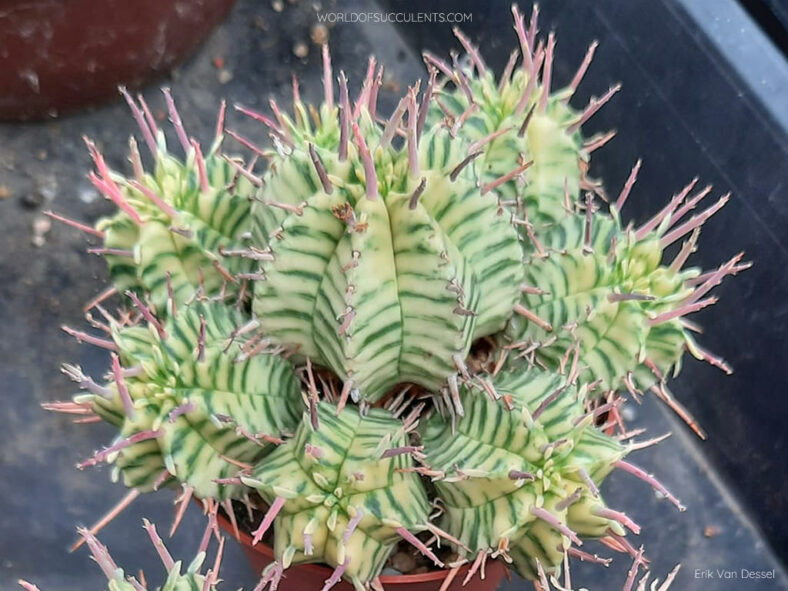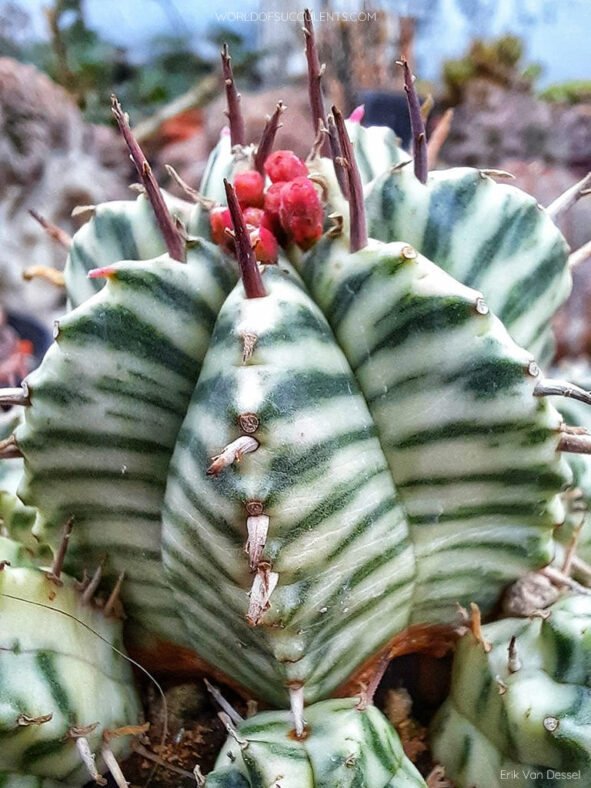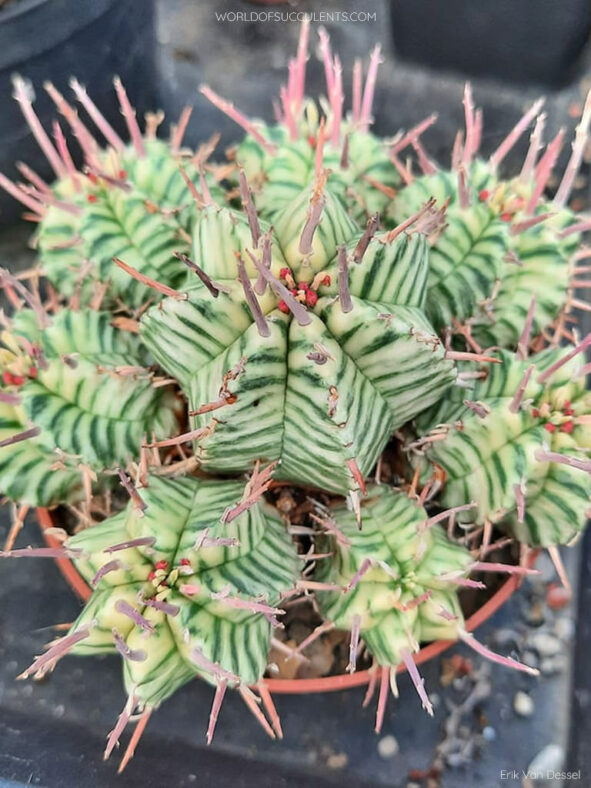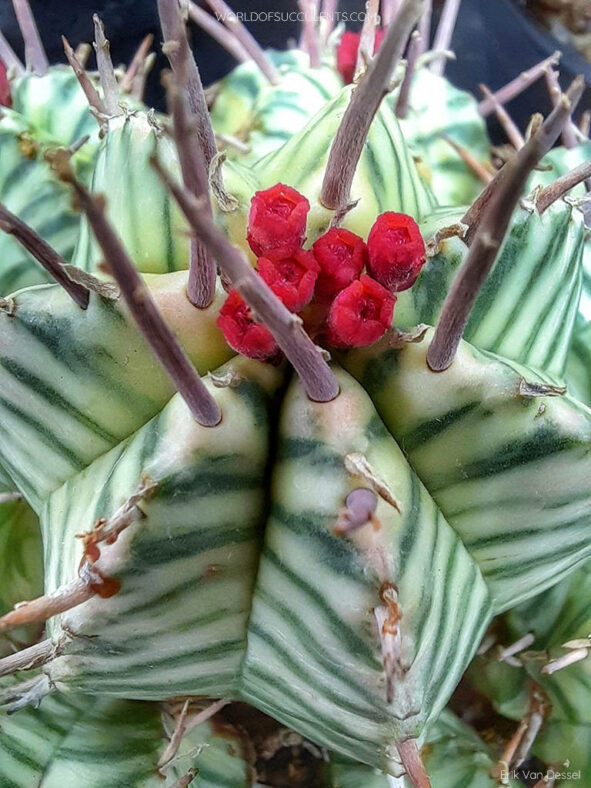Euphorbia pulvinata 'Variegata' is a must-have addition to your collection. This sculptural plant is simply stunning and will add a touch of natural beauty to any space.
Scientific Name
Euphorbia pulvinata 'Variegata'
Accepted Scientific Name
Euphorbia pulvinata Marloth
Synonym(s)
Euphorbia pulvinata f. variegata
Scientific Classification
Family: Euphorbiaceae
Subfamily: Euphorbioideae
Tribe: Euphorbieae
Subtribe: Euphorbiinae
Genus: Euphorbia
Origin
Euphorbia pulvinata 'Variegata' originated in a commercial cactus nursery in Ventimiglia, Italy, as a single offset to a normal green Euphorbia pulvinata. The owner reproduced it by the thousands in a decade or so, then sold the whole (about 10,000 plants) to Giromagi.
Description
Euphorbia pulvinata 'Variegata', usually sold as Euphorbia meloformis 'Variegata', is an attractive small succulent that freely branches at the base, forming a clump of variegated, densely packed stems. The stems are creamy with stunning green markings, often displaying beautiful shades of pink. They are typically 7-angled, initially spherical, becoming columnar with age, and can grow up to 5 inches (12.5 cm) tall and 1.4 inches (3.5 cm) in diameter. The leaves are rudimentary and soon fall off, leaving tiny white scars on the stems. The spines are modified sterile peduncles, ranging in color from white to purple and growing up to 0.5 inches (1.2 cm) long. They are solitary and irregularly scattered along the angles of the stems.
The flowers are usually dark red-purple, measuring up to 0.15 inches (0.3 cm) in diameter, and appear in clusters at the tip of the stems in winter and spring. The fruits are obtusely 3-angled capsules with pale brown seeds and can reach up to 0.2 inches (0.5 cm) in diameter.

How to Grow and Care for Euphorbia pulvinata 'Variegata'
Light: Providing your Euphorbia pulvinata 'Variegata' with plenty of sunlight is important for optimal growth. Place it near a sunny window or move it to your balcony or garden during the warmer months, gradually increasing sun exposure to avoid sunburn.
Soil: Use a well-draining soil, either a commercial potting mix formulated for succulents or create your own well-draining soil.
Temperature: While high summer temperatures are not a problem, low winter temperatures can damage or kill your plant. Euphorbia pulvinata 'Variegata' grows best in USDA Plant Hardiness Zones 9a to 11b, with average minimum winter temperatures ranging from 20 to 50 °F (-6.7 to 10 °C).
Watering: From spring to fall, water the plant when the top inch (2.5 cm) of soil feels dry. Reduce watering in winter and give it just enough water to prevent wilting. The evening is the best time of the day for watering in the warm season.
Fertilizing: To ensure the potted plant receives sufficient nutrients, apply a balanced fertilizer in a 10-10-10 NPK formulation, diluted to 1/4 strength weekly during the growing season.
Repotting: Although your Euphorbia pulvinata 'Variegata' does not need to be repotted often, it will benefit from repotting when it outgrows its pot. The repotting is best done in early spring at the beginning of the growing season. Wear gloves, protective clothing, and appropriate eye protection when handling this plant.
Propagation: The easiest and quickest way to propagate this plant is by stem cuttings. Although it can be started from seeds, it can be difficult for them to germinate. Take cuttings during the growing season; spring is the best time to sow seeds.
Learn more at How to Grow and Care for Euphorbia.
Toxicity of Euphorbia pulvinata 'Variegata'
Euphorbia pulvinata 'Variegata' produces a poisonous white milky sap that may cause burns or irritation if in contact with the skin or eyes. Therefore, keeping this plant away from children and pets is best.
Links
- Back to genus Euphorbia
- Succupedia: Browse succulents by Scientific Name, Common Name, Genus, Family, USDA Hardiness Zone, Origin, or cacti by Genus
Photo Gallery
Click on a photo to see a larger version.


